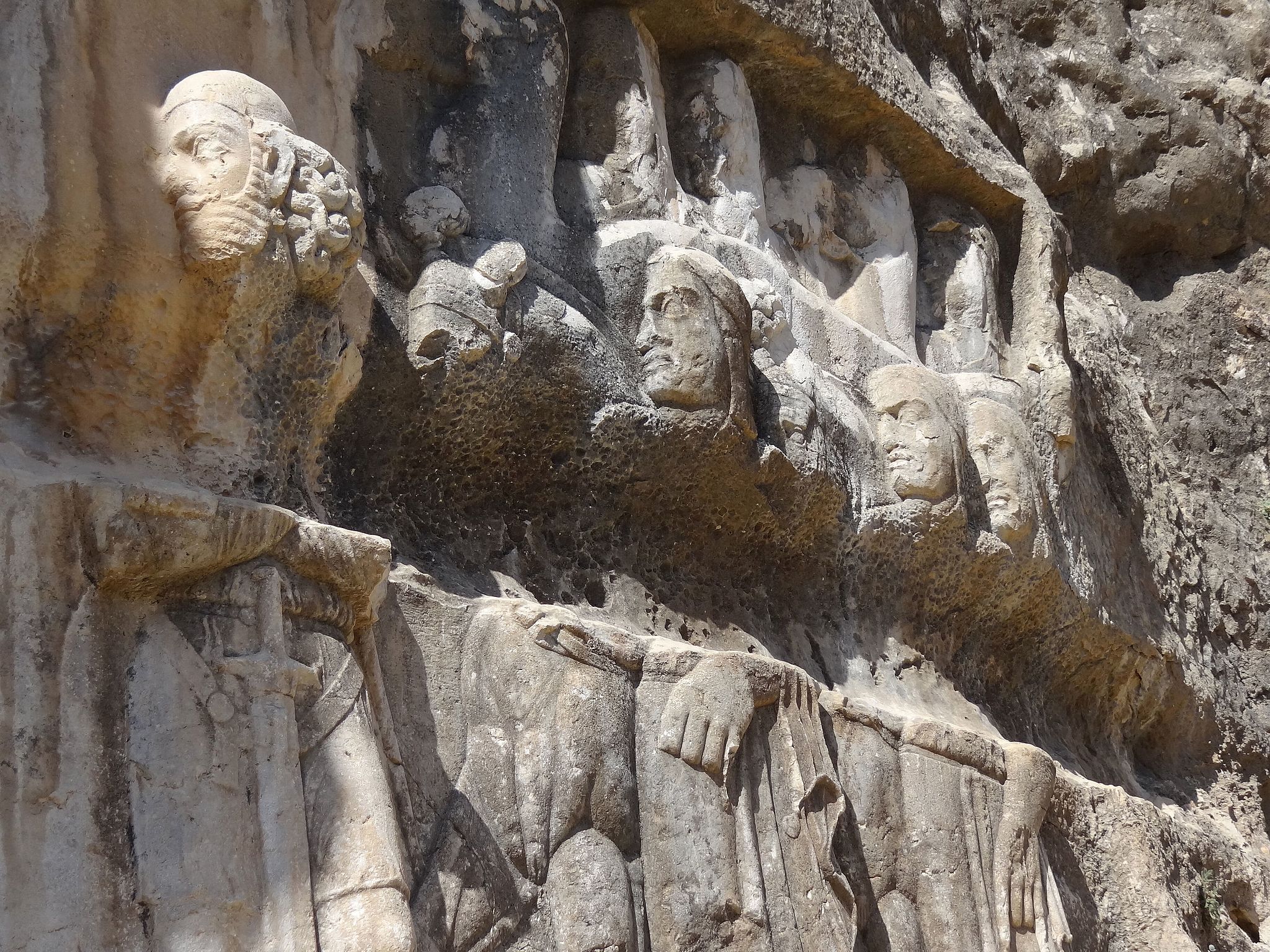Table of Contents
The Sassanian (or Sasanid) dynasty, an ancient Iranian empire that emerged from the conquests of Ardeshir I in 208-224 CE and lasted from 224-651 CE, left behind a rich legacy of art and culture. The dynasty, named after Sasan, an ancestor of Ardeshir, constantly adjusted its borders in response to other empires such as Rome, Byzantium, Kushans, and Hephthalites.
During the Sassanian era, Zoroastrianism was the state religion, and this had a tremendous impact on the cultural, political and social aspects of the Sasanian era, which is well visible in the art of this period.
One of the most fascinating aspects of the Sassanian legacy is their bas-reliefs, which offer a glimpse into the customs, beliefs, and achievements of this ancient civilization. Join us as we embark on a journey through the world of Sassanian bas-reliefs, and uncover the secrets they hold.
The Magnificent Sassanian Reliefs: Discover the Art and Culture of an Ancient Dynasty
During the Sassanian period, Iranian art experienced a renaissance. Grandiose architecture, such as the palaces at Ctesiphon, Firuzabad, and Sarvestan, showcased the dynasty’s power and wealth. However, the most striking and characteristic relics of Sassanian art are the rock sculptures carved on abrupt limestone cliffs.
Research and studies in this field show that Sassanian artists and sculptors drew inspiration from two main religious and non-religious subjects for sculpting reliefs, as well as a combination of both. Religious scenes typically depict the crowning of kings by Ahura Mazda and Anahita or prayer, while non-religious scenes depict equestrian battles, victories, family life, royal courtiers, animal battles, and hunting. Some reliefs even combine two themes into one scene, such as taking the crown from Ahura Mazda and victory over the enemy.
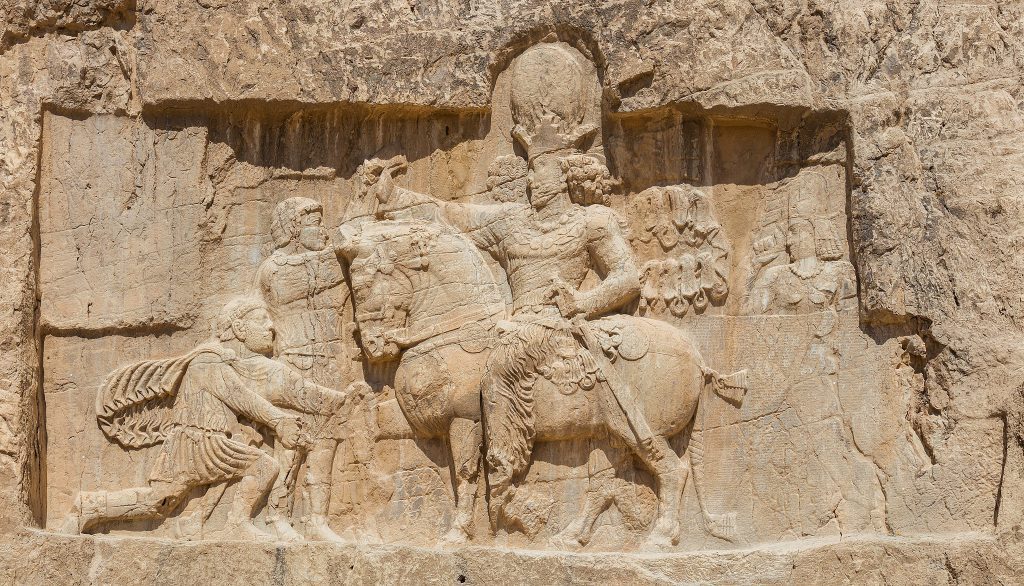
A total of 36 Sassanian reliefs have been found, with the majority located in the Fars province, including Firuzabad Tangab, Naqsh-e Rajab, Naqsh-e Rustam, Bishapur Tang-e Chogan, Tang-e Qandil, Goyum, Baram Delak, Sar Mashhad, Sarab Bahram, and Darabgerd. UNESCO World Heritage Sites Firuzabad (Ardashir Khurreh) and Bishapur offer significant testimonies of the earliest moments of the Sassanian Empire, under Ardashir I’s commencement and the establishment of power under both Ardashir I and his successor Shapur I.
The Sassanian bas-reliefs showcase the optimal exploitation of local natural resources, such as mountains, plains, and rivers, in a diverse set of urban structures, castles, buildings, and monuments. Zoroastrianism can be seen in the Sassanian bas-reliefs, as depicted in the coronation of Sassanian kings by Ahura Mazda, the great God and Anahita, the goddess of water. Most of the reliefs were carved within the Sassanian home province of Pars during the first 175 years of the empire, between the reigns of Ardashir I (r. 224–241) and Shapur III (r. 383–388).
In the rest of this article, we will take you on a journey through five of the most important Sassanian reliefs, where you will discover the incredible art and culture of this ancient dynasty. Immerse yourself in the rich history of Sassanian art and marvel at the incredible craftsmanship of these stunning reliefs.
The Majestic Sassanian Reliefs of Firuzabad
Nestled in the heart of Firuzabad, Fars, lies a thirty-kilometer-long gorge known as “Firuzabad Tangab,” which also serves as the road between Shiraz and Firuzabad. Here, a serene river flows through lush almond and pistachio trees, offering a tranquil escape from the hustle and bustle of modern life. At the end of the gorge, about fifteen kilometers northwest of Firuzabad city, you’ll find two stunning reliefs carved into the mountain’s stone walls, three kilometers apart.
The first relief depicts the victorious battle of Ardeshir Babakan over Ardavan V, the last king of Parthians, while the second scene depicts Ardeshir Babakan taking the crown from Ahura Mazda. These reliefs are a testament to the incredible artistry and craftsmanship of the Sassanian Empire.
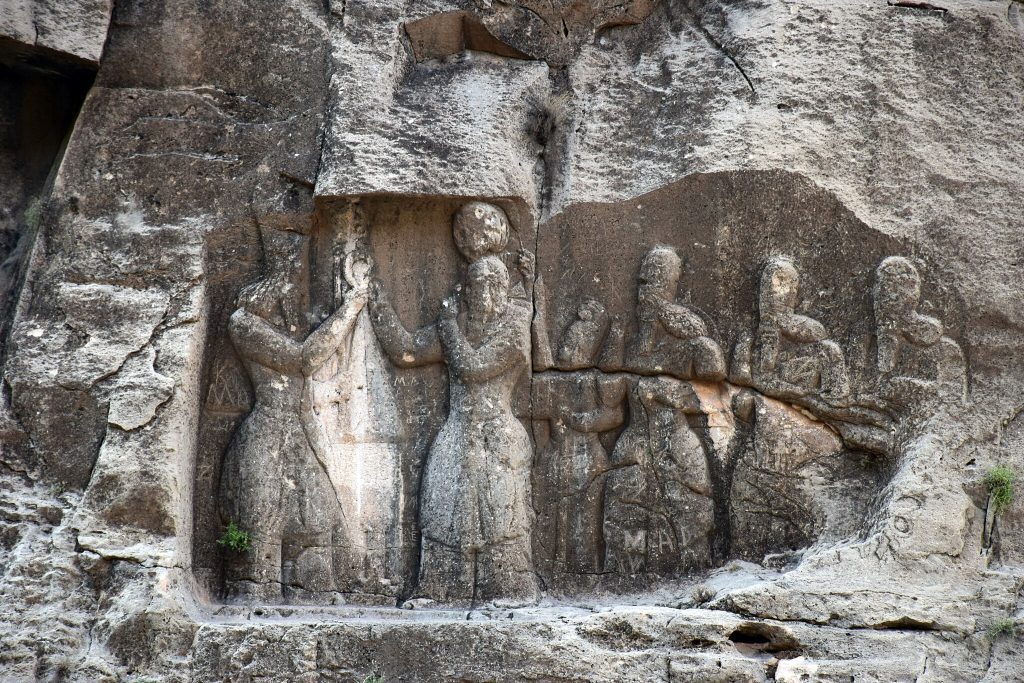
In regard to the Sassanian era, kings can be distinguished based on the characteristics of their crowns, which are evident in the common coins of each king’s time. In the second relief, you’ll see the great god Ahuramazda and Ardeshir Babakan depicted on both sides of a small fire pit, facing each other. Although they are the same height and build, their hairstyles and crowns set them apart. The king extends his right hand to take the royal ring, while his left hand is raised to his face, with his index finger extended as a sign of respect.
As you explore the Firuzabad Tangab gorge, you’ll be transported back in time to ancient Persia and will discover the rich history and culture of the Sassanian dynasty. The Sassanian reliefs of Firuzabad are a must-see for anyone interested in ancient art and history, showcasing the dynasty’s power and might, as well as their incredible artistic abilities.
Explore Naqsh-e Rajab’s Stunning Sassanian Reliefs
Located just three kilometers north of Persepolis and one and a half kilometers south of the ancient city of Estakhr, lies a site of great historical significance – Naqsh-e Rajab. Often referred to as “the Figure of Heroes,” this place features three breathtaking Sassanian reliefs that provide a glimpse into the power and majesty of ancient Persia.
One relief depicts Ardeshir Babakan being crowned by Ahura Mazda, while another portrays Shapur I’s presence in a gathering of courtiers. The third relief shows Shapur I’s coronation by Ahura Mazda. Unfortunately, the relief of Ardeshir Babakan’s coronation has been lost to natural events and stone decomposition.
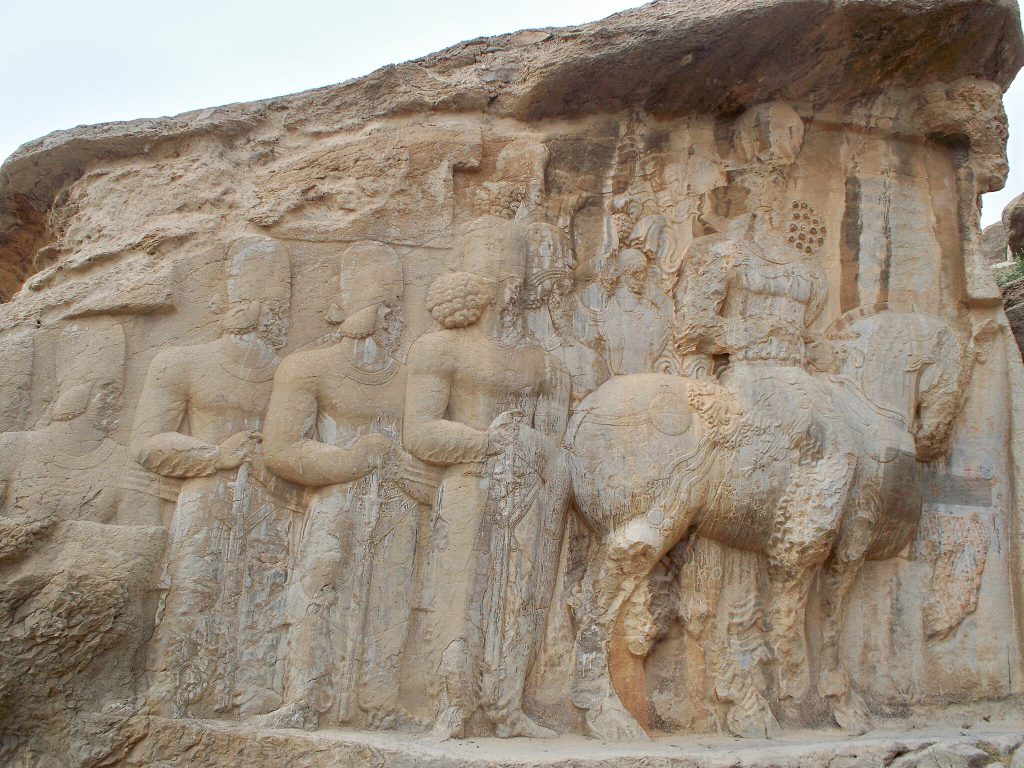
The relief of Shapur I’s coronation is a masterpiece of Sassanian period sculptural art. It features the Sassanian king and Ahura Mazda on horseback, facing each other. Unlike the relief of Ardeshir Babakan’s coronation, the king is on the right, and Ahura Mazda is on the left. However, the rest of the relief is very similar to that of Ardeshir Babakan’s coronation. Although the king’s face is missing, it is similar to Ahura Mazda in other cases.
The relief of Shapur I among the courtiers is another remarkable work of art. It features Shapur and nine members of the royal family and courtiers, and inscriptions in Sasanian Pahlavi and Greek, both emphasizing Shapur’s legitimacy from Ahura Mazda and Ardeshir Babakan.
The Splendor of Naqsh-e Rostam’s Sassanian Reliefs
Naqsh-e Rostam, located just 6 kilometers away from Persepolis in the north of Marvdasht city, is a site of great historical significance. This ancient complex comprises monuments from the Elamites, Achaemenids, and Sassanids, including numerous reliefs depicting important events of the Sassanid era. Naqsh-e Rostam was considered a crucial site from both religious and national perspectives during the Sassanid period.
Formerly known as Mount Hajiabad, the site was renamed Naqsh-e Rostam after locals connected Rostam, the legendary hero from Shahnameh, with the Sassanian kings depicted in the reliefs. Mount Hajiabad has been a sacred and respected place since ancient times, attracting visitors who come to pay their respects to the graves of their kings, see the fire place, and offer their prayers and needs.

Among the Sassanian remains at Naqsh-e Rostam, eight reliefs stand out. Witness Ardeshir Babakan crowning Ahura Mazda and his victory over Ardavan V, Bahram II in the presence of courtiers, and the battle scenes of Bahram IV’s horse and Hormuzd II’s cavalry. Although faded, the fifth relief depicts Shapur II, and the sixth relief shows Shapur I’s victory over the Roman emperors. The seventh relief contains two different scenes from the cavalry battle of Sassanid kings: the upper scene belongs to Bahram II, and the lower scene belongs to Bahram IV. Finally, the eighth relief shows Narse, the seventh king of Sassanid, taking the crown from the water goddess Anahita at Naqsh-e Rostam.
With its fascinating collection of reliefs and rich cultural history, a visit to Naqsh-e Rostam is a must-see for anyone interested in Iran’s heritage.
Bishapur’s Sassanian Reliefs: A Peek into Iran’s Rich Past
Bishapur, located 154 km west of Shiraz city and 23 km west of Kazerun city, is a historic city and one of the most renowned Sassanian cities. It held a significant position during Shapur I’s reign, and its northern valley contains Tang-e Chogan (Polo) Gorge, named after one of the most popular games played by Sassanian kings. The Shahi road, connecting Firuzabad and Bishapur to Ctesiphon – the capital of the Sassanid government – runs alongside the gorge, and the Shapur river flows through it.
On the left bank of the river, two reliefs depict Shapur I being crowned by Ahura Mazda and his victory over the Roman emperors. On the right bank, four reliefs portray Shapur I’s triumph over the Romans, Bahram II’s victory over the Arabs, Bahram I’s coronation by Ahura Mazda, and Bahram II’s victory over the king of India.
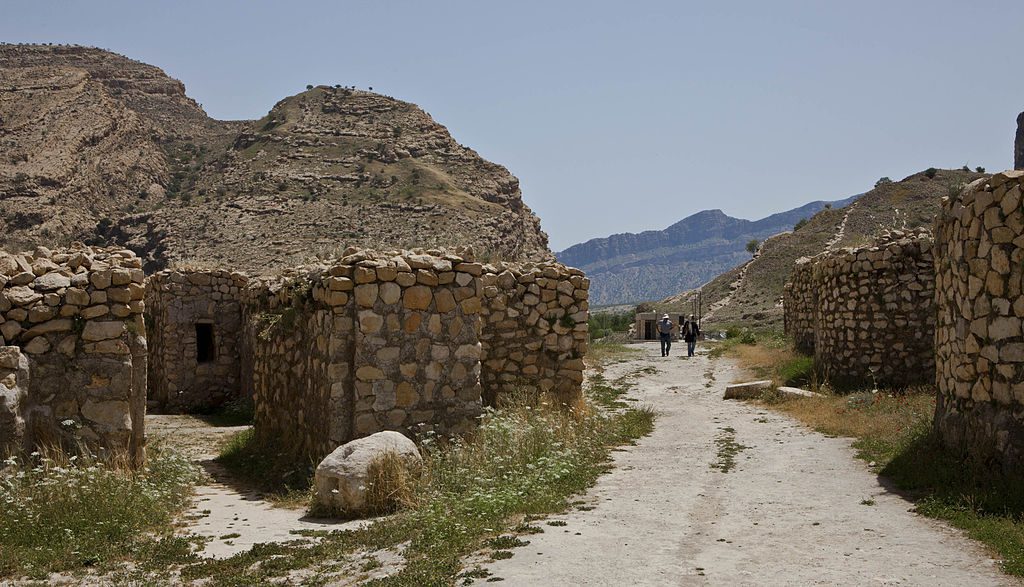
Bishapur’s Sassanian reliefs offer a captivating insight into the opulence and grandeur of ancient Persia. A visit to this site provides a rare opportunity to witness the extraordinary achievements of the Sassanian kings and their love of sports, as demonstrated by their passion for Polo. It’s worth mentioning that it’s part of the Fars region’s Sassanid archaeological landscape, which received UNESCO World Heritage status in 2018.
The Wonders of Taq-e Bostan’s Sassanian Reliefs
Nestled in the northeastern edge of Kermanshah city, lies the awe-inspiring Taq-e Bostan (Bostan arches). Its reputation stems from the presence of two arches – one small and the other large – on the chest of the mountain. Taq-e Bostan is home to several Sassanian reliefs that provide a glimpse into the glory of ancient Persia.
The small arch of Taq-e Bostan features reliefs of Ardeshir II’s coronation, the tenth Sassanid king, by Ahura Mazda, and his victory over the enemy, carved on the right edge of the arch. Inside the small arch, you’ll find a family scene of Shapur II and III, showcasing the Sassanian kings’ family life.
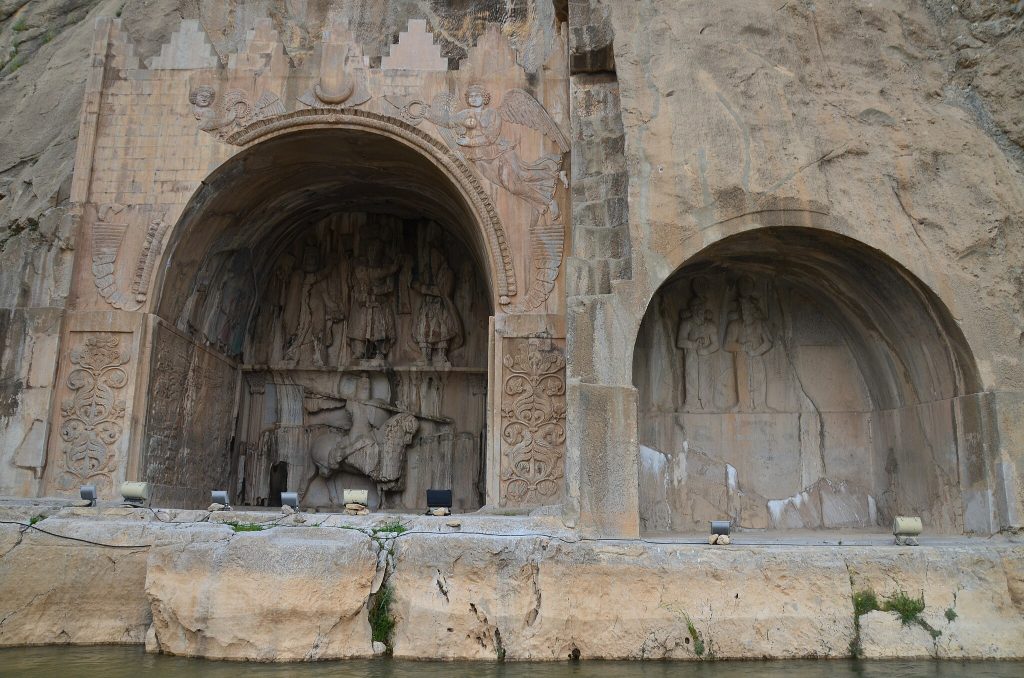
One of the most remarkable reliefs at Taq-e Bostan is the coronation of Pirouz from Ahura Mazda, with the presence of the water goddess Anahita. This scene is a true marvel of Sassanian period sculptural art, showing the king in his full regalia, ready to assume his duties.
Another fascinating relief depicts the king riding and wearing armor, displaying his military power and might. And, for hunting enthusiasts, there’s a scene of hunting that showcases the Sassanian kings’ passion for this activity.
FAQ about Sassanian Bas-Reliefs
Q: What is the Sassanian dynasty?
A: The Sassanian dynasty was an ancient Iranian empire that existed from 224-651 CE. It emerged from the conquests of Ardeshir I and was named after Sasan, an ancestor of Ardeshir. The dynasty constantly adjusted its borders in response to other empires such as Rome, Byzantium, Kushans, and Hephthalites.
Q: How did Zoroastrianism influence the Sassanian era?
A: Zoroastrianism was the state religion during the Sassanian era, and it had a significant impact on the cultural, political, and social aspects of that time. The influence of Zoroastrianism can be seen in the art of the period, particularly in the depiction of religious scenes such as the crowning of kings by Ahura Mazda and Anahita or prayer.
Q: What are Sassanian bas-reliefs?
A: Sassanian bas-reliefs are rock sculptures carved on abrupt limestone cliffs that offer a glimpse into the customs, beliefs, and achievements of the Sassanian civilization. They depict a variety of subjects, including religious scenes such as the crowning of kings and non-religious scenes such as equestrian battles, victories, family life, royal courtiers, animal battles, and hunting.
Q: Where are Sassanian bas-reliefs found?
A: A total of 36 Sassanian bas-reliefs have been found, with the majority located in the Fars province of Iran. Some notable sites include Firuzabad Tangab, Naqsh-e Rajab, Naqsh-e Rustam, Bishapur Tang-e Chogan, Tang-e Qandil, Goyum, Baram Delak, Sar Mashhad, Sarab Bahram, and Darabgerd.
Q: What is the significance of the Sassanian bas-reliefs?
A: The Sassanian bas-reliefs are significant because they showcase the artistic and cultural achievements of the Sassanian dynasty. They provide valuable insights into the history, beliefs, and lifestyle of this ancient civilization. The bas-reliefs also demonstrate the Sassanian’s mastery of utilizing local natural resources and their architectural prowess.
Q: Can you provide some examples of notable Sassanian bas-reliefs?
A: Some notable Sassanian bas-reliefs include those found at Firuzabad Tangab, Naqsh-e Rajab, Naqsh-e Rustam, Bishapur Tang-e Chogan, and Taq-e Bostan. These reliefs depict scenes such as the victorious battles of Sassanian kings, their coronations, presence in gatherings, and hunting activities.
Q: Where can I see the Sassanian bas-reliefs?
A: The Sassanian bas-reliefs are located at various sites in Iran, particularly in the Fars province. Some of these sites, such as Firuzabad, Naqsh-e Rajab, Naqsh-e Rustam, Bishapur, and Taq-e Bostan, are open to visitors and offer the opportunity to witness these magnificent works of art in person.
Q: What can I expect to see during a visit to the Sassanian bas-reliefs?
A: During a visit to the Sassanian bas-reliefs, you can expect to see intricately carved rock sculptures depicting scenes from Sassanian history, including battles, coronations, and everyday life. You’ll have the chance to appreciate the artistic craftsmanship of these reliefs and gain a deeper understanding of the cultural and historical significance of the Sassanian dynasty.
Embark on a Knowledge-Based Archaeological Tour in Iran
If you’re a history enthusiast and eager to explore the rich archaeological sites of Iran, then planning a knowledge-based tour is the perfect way to immerse yourself in the country’s ancient wonders. Iran is home to a plethora of remarkable archaeological sites that offer a glimpse into its rich and diverse history, from the magnificent ruins of Persepolis to the intricate rock reliefs of the Sassanian era.
To ensure you have the best experience while exploring Iran’s archaeological treasures, consider embarking on a customized tour designed specifically for archaeology enthusiasts. By choosing a specialized tour, you can focus on visiting the most significant archaeological sites, gaining in-depth knowledge from expert guides, and delving into the fascinating historical context behind each site.
Discover Iran’s Archaeological Heritage with ToIranTour
When it comes to planning your knowledge-based archaeological tour in Iran, look no further than ToIranTour. As a leading tour operator specializing in Iran tours and travel packages, ToIranTour offers a range of options tailored to meet the preferences and interests of every traveler.
With ToIranTour, you can expect meticulously planned itineraries that highlight the best archaeological sites in Iran. From the grandeur of Persepolis and the mystique of Pasargadae to the captivating Sassanian reliefs and the awe-inspiring Taq-e Bostan, each tour is thoughtfully crafted to provide an unforgettable experience.
The team at ToIranTour understands that each traveler has unique interests and preferences. Therefore, they strive to design customized tours that cater to individual needs, whether you’re passionate about ancient architecture, art, or specific historical periods. Their knowledgeable guides will accompany you throughout the journey, sharing their expertise and deep insights into Iran’s archaeological heritage.
We’re Here to Make Your Experience in Iran Extraordinary
At ToIranTour, our goal is to ensure that your archaeological tour in Iran surpasses all expectations. We are committed to providing exceptional service, creating immersive experiences, and offering unparalleled access to Iran’s archaeological wonders. Our passion for Iran’s history and culture drives us to deliver unforgettable journeys that leave a lasting impact.
Whether you’re a seasoned archaeology enthusiast or a curious traveler with a thirst for knowledge, let ToIranTour be your trusted companion in uncovering Iran’s archaeological treasures. Join us on an extraordinary adventure through time as we explore the ancient marvels that have shaped the rich tapestry of Iranian history.
Contact us today to begin planning your customized archaeological tour and embark on a captivating journey through the ancient wonders of Iran. With ToIranTour, you can be assured of an experience that will create lasting memories and deepen your appreciation for Iran’s remarkable archaeological heritage.
Conclusion
As we conclude our exploration of the Sassanid bas-reliefs, it’s clear that this era left a valuable and marvelous collection. The artistic and architectural approaches of earlier civilizations of Elamite and Achaemenians can be seen in the rock-carving techniques and designs of the reliefs in Sasanian period.
Whether you’re a history buff or simply curious about the ancient world, there’s something truly special about standing in the presence of these masterpieces. By appreciating the beauty and historical significance of these sculptures, you’re not just learning about the Sassanian dynasty and its cultural legacy, you’re also connecting with a rich and fascinating period of human history. So why not plan a visit to the Sassanid sites and see these magnificent works of art for yourself? You don’t need to be an expert to appreciate the majesty of these ancient relics – they’re truly a sight to behold!
